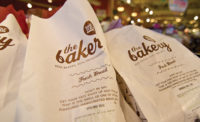Fresh Identity for Healthful Brands
Introduces Dozens of New Products in New Categories
by Lori Dahm
photo by Vito Palmisano
It’s not any company that can forge into new categories, introduce 34 products within nine months and meet with success. But that’s the story behind Madison, Wis.-based Back to Nature, a company acquired by Kraft Foods in August 2003. To accomplish this daunting new product avalanche, Kraft charged Kevin Scott, senior vice president of external development and strategy and general manager of natural and organic foods, with establishing an entrepreneurial spirit and process at Back to Nature to achieve its mission.
Taking a brand previously only present in cereal and granola into four new categories was a tall order, and Scott translated his experience growing and managing the Kraft business — including the Tombstone, DiGiorno, Jack’s and California Pizza Kitchen brands — to hit the ground running. Additionally, Scott’s recent experience expanding the Boca meat alternatives line into organic laid the groundwork for the Back to Nature process.
The result has been formidable, as Back to Nature has a new, clearly defined brand identity and has met with consumer acceptance in all of its new formats. Accomplishing such complex new product introduction numbers required a well-planned cross-divisional strategy, brilliant leadership and focus on innovation, all synergistically applied to product development processes. It’s a tale of many years of expertise and learning coming together to yield notable success.
From the top
Some of the Back to Nature new product push may have come after Kraft’s Sustainable Growth Plan was revealed in February 2004, at a Consumer Analyst Group Conference. Chief Executive Officer Roger Deromedi mentioned that transforming the company’s portfolio was a key strategy, including initiatives that would meet consumer demand for health and wellness products and for convenience.
“The growing importance of health and wellness has significantly altered consumption and buying behaviors,” Deromedi said back then. “ … greater demand for organic and natural products are requiring a shift in what we market and how we market it.”
Natural and organic are two of the key areas of opportunity that Kraft is focusing on as part of the company’s health and wellness strategy.
“What other part of the food industry is growing at the double-digit growth that has been seen in natural and organic over the last 10 years?” says Scott. “We believe natural and organic will continue to expand in natural channels and in conventional supermarkets. Our acquisition of Back to Nature is a testimony to our belief in the opportunity within this category.”
Jump start
Back to Nature was founded in Pasadena, Calif., in the 1960s, with products sold in the cereal aisle over the ensuing 40 years. When acquired by Kraft in 2003, the Back to Nature cereal and granola line consisted of 13 products.
Part of the reason that Back to Nature was able to introduce a wide array of new products so rapidly is due to the urgency with which Kraft directed the company immediately after the acquisition.
“From the outset of our Back to Nature acquisition, our intention was to be entrepreneurial in nature,” says Scott. “We created a center of natural and organic expertise while leveraging the infrastructure of Kraft, working across categories to do so.”
Within two days of the acquisition, company leaders were outlining the goals and objectives for Back to Nature, while defining the “ingredient principles” that would guide upcoming new product introductions and align with natural/organic consumer preferences. The team outlined ingredient principles to bring forward the best-tasting products nature could offer — Back to Nature products would include no artificial preservatives, colors or flavors, no hydrogenated oils or natural sweetening systems.
“We performed a lot of research before the acquisition, about the company as well as the industry. We spent considerable time with natural and organic consumers to gather their thoughts relative to unmet needs in product performance and delivery,” says Scott. “This preparation, coupled with having a wealth of experience working on new products within Kraft, allowed us to re-tool a brand and product line quickly to provide a new foundation for Back to Nature.”
Other important aspects of establishing the Back to Nature brand included infusing the new acquisition with a strong positive motivation and attitude, and innovative product developers were assisted by numerous experts from Kraft.
“We believe innovation is a cornerstone of the Back to Nature brand. Then we staffed accordingly,” says Scott. “In an entrepreneurial setting, there is a certain amount of optimism you have to have, a spirit you must maintain and a certain amount of ‘lack of process’ you have to be comfortable with. We needed people who could walk that line.”
At Back to Nature, the product developers are part of consumer focus groups so they can keep abreast of what consumers are seeking. All functions are encouraged to be immersed in the consumer side of new product development and research.
The entrepreneurial spirit within Back to Nature helped propel the creation of 34 new products within a year, 19 in categories where the Back to Nature brand had previously not been present.
Currently, Back to Nature appears in natural channels and is distributed into conventional stores. Because much of the brand identity and new product concepts resulted from consumer research with natural shoppers, the brand is successful in the natural channels where clearly demonstrated need has driven product development.
Building a brand
The development and positioning of the Back to Nature brand is based on clear natural/organic consumer insights.
“Building a brand is a journey that starts with understanding your consumer and working out from that,” says Scott. “Back to Nature is a brand that strikes a balance between elements of simplicity and uniqueness. Our products offer a superior taste and ‘natural’ product identity that is important to the natural consumer.”
There is no doubt that the natural consumer is different than consumers who purchase other mainstream Kraft brands. For one, these consumers have limited interest in traditional forms of advertising, and instead are influenced by products that touch their lives in non-traditional and compelling ways.
An innovative strategy was employed in developing the marketing and advertising to support the Back to Nature product launch. Print materials were designed to educate and inform about food choices for natural lifestyles.
The Back to Nature brand also differs from Kraft’s other traditional brand identities in that the company logo and packaging were designed to foster a small company feel and look. Consumer feedback helped develop the Back to Nature logo since the company did not want an image that would be perceived as too slick and glossy for a natural products company.
Although some diehard natural and organic consumers seem willing to be taste martyrs to sustain their food purchase choices, Back to Nature aims to offer natural and organic products that always deliver against exceedingly high taste expectations.
And finally, the positioning of the Back to Nature brand is about convenience. Particularly through packaging, these new products are designed to offer consumers a more convenient way of consuming cereals, snacks and cheeses. For example, all of the newly introduced granolas and cereals have reclose/reseal benefits with press-to-seal bag packaging. The cookies are in a tin tub that offers reclose/reseal benefits, and the organic cheese shreds and cubes feature a slider zipper.
“It is incumbent upon all of us here at Back to Nature to define success by providing a meaningful difference to the consumer and the retailer. The beauty of our products is that often they hit upon innovation in three dimensions — taste, form and packaging,” says Scott. “Innovation is key to making better products that consumers want to see on the shelves. Across every one of our new products we ask the question, ‘Why Back to Nature?’”
The products
The initial stages of the 34 new products started with plans to reinvent the existing Back to Nature cereal and granola businesses that were part of the acquisition. This required replacing the soy ingredients that weren’t identity-preserved with soy ingredients that were either organic or non-GMO.
The existing cereal and granola line delivered a good texture balance between flakes, muesli and granola, but fruit was absent from the line. So the emphasis became bringing fruit into the new cereals while continuing to offer consumers texture variety.
The company introduced eight new varieties of cereal in May 2004. All of the cereals are low in fat, have no cholesterol, are good sources of fiber and some have high levels of protein. Although organic ingredients are included in the cereals, they do not reach the organic label hurdle of 75%.
One of the strengths of the Back to Nature brand was the granola line. Tapping into Kraft reformulation expertise while adding fruit into the granola line was a simple way of introducing a significant number of new products within a relatively short timeframe.
Next, the company decided to focus on entering new categories where the expertise in place at Kraft could help deliver superior tasting, convenient new products. Cookies, crackers, macaroni-and-cheese dinners and cheese became the areas of focus, with a total of 19 new products in these categories.
“If you look at the categories we entered, Kraft and Nabisco together presented a number of strengths and competencies — in consumer insight, technologies, capital assets, current manufacture of similar products — all of that infrastructure in those categories proved to be very helpful,” says Scott. “Then we researched across categories and determined where there was a strong consumer interest and need for further variety and improved taste profile. Within these categories, consumers were looking for more variety and greater innovation.”
The Back to Nature line of cookies and crackers was introduced in May, all made without artificial flavors, colors and preservatives, free of hydrogenated oils and with zero grams of trans fat. The cracker varieties introduced were Crispy Wheats, Classic Rounds buttery crisp crackers, White Cheddar Rice Thins and Sesame Ginger Rice Thins.
“Although [some natural and organic consumers] desire more esoteric offerings of flavor or form, most want products they were familiar with,” says Scott. “Our four new crackers are a perfect example of a mix between two familiar forms and flavors and two fairly innovative flavor profiles in a new form.”
In the cookie category, the new Back to Nature products introduced in May were Chocolate Chunk Cookies, Oatmeal Cookies, Classic Sandwich Crème Cookies and Chocolate and Mint Sandwich Crème Cookies. The Oatmeal and Classic Sandwich Crème Cookies offer consumers a familiar product in a natural format, the Chocolate Chunk cookie is pumped full of chocolate and the Chocolate and Mint Sandwich Crème is a slightly new take upon the familiar sandwich cookie.
The name Kraft is synonymous with macaroni and cheese. However, one distinctive difference with the new Back to Nature varieties is that all of the cheese sauces in the dinners are organic.
The new Back to Nature dinners are made with naturally aged, certified organic Cheddar cheese; White Cheddar and Spirals, made with organic white Cheddar cheese sauce; Crazy Bugs Mac and Cheese with organic, aged Cheddar cheese sauce and fun bug shapes for kids; and Alfredo and Gemilli, with organic Alfredo cheese sauce and twisted gemelli pasta.
The dramatic growth in the organic dairy segment spoke volumes about the opportunity in organic cheese, and the seven new Back to Nature cheese products are 100% organic.
“When developing the Back to Nature cheese products, we approached Kraft experts who have been working in cheese technology for 25 years and gave them new ingredients, new processing parameters, and learned a lot about making organic cheese,” says Scott.
The seven new Back to Nature cheeses are Organic Cream Cheese, Organic Neufchatel Cheese, Organic Shredded Mozzarella, Organic Shredded Cheddar Cheese, Organic Cheddar Cheese Cubes, Organic American Cheese Slices and Organic White Cheddar Cheese Slices. Back to Nature is the first company to offer organic processed cheese, and the first to offer an inner-wrap in an organic cheese product, which delivers the deli effect.
Already, retailers and consumers are pulling products through rotation and indicating that the new brand is offering consumers the taste, convenience and difference they are seeking.
“As we think about growing the Back to Nature business, new product development is going to continue playing a significant role,” says Scott. “Granted, partly this is because we didn’t have a very big product line to begin with, but there are also a lot of unmet consumer needs out there.
“As Back to Nature moves ahead, we will see further expansion in categories we’ve already chosen to compete in, and also enter new categories when the timing is right,” says Scott. “We will launch new products when there are clear consumer needs that combine with our ability to build upon our existing expertise. We are excited about the opportunity to better address consumer needs while building the Back to Nature business with innovative new products.”
Editor’s Note: Lori Dahm is executive editor of Stagnito’s New Products magazine.




